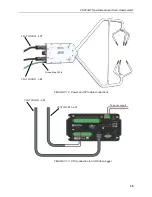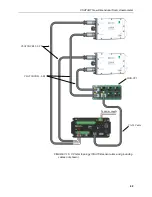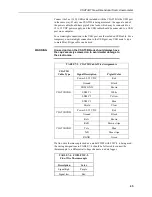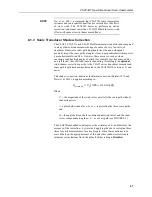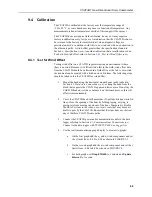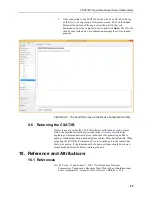
CSAT3B Three-Dimensional Sonic Anemometer
50
8.2.1 Measurement Trigger
A measurement trigger is the actual command to initiate a sonic measurement
and can be driven by either a data logger or the CSAT3B internal timer. If the
trigger is given by a data logger as in Mode 0, then no data filtering is done
(bandwidth is wide open) since each trigger will initiate a single new
measurement (single-measurement regime). The data logger can trigger
measurements at rates from 1 to 100 Hz. If the trigger is given by the internal
CSAT3B timer as in Modes 1
˗
3, the measurements will be self triggered at a
rate of 100 Hz. This results in an oversampled measurement regime where the
100 Hz samples may be optionally processed through a filter before being
downsampled or decimated and output.
If a data logger fails to provide a trigger and the CSAT3B has not
been configured for unprompted output, the CSAT3B will enter
into a lost-trigger state where it will output measurements at 1 Hz
based on its internal timer. If the CSAT3B is in a lost-trigger state
while connected with
Device Configuration Utility
, real-time
anemometer data will flash on the screen at one second intervals
and the LED
Status
light on the CSAT3B head will flash red.
This is an indication that the settings should be checked. It does
not indicate a problem with the CSAT3B hardware. Once a
trigger is received by the CSAT3B, or once unprompted output is
enabled, normal operation will ensue.
8.2.2 Data Filter
The optional data filter (Modes 1 and 3) takes the 100 Hz sample points that
were self triggered by the CSAT3B and runs them through a low-pass (high-
cut) filter, resulting in a new filtered output at the same 100 Hz rate. The
degree to which the data are filtered is determined by the user-selected filter
bandwidth. This is selected from the
Device Configuration Utility
in the
Measurement Settings
tab.
The bandwidth is the frequency at which a signal is filtered to (1-1/e) of its
original power. In cases where unaliased spectra from the CSAT3B are to be
analyzed, the user should choose a filter bandwidth that is at the Nyquist
frequency, which is half the data output rate from the CSAT3B to the data
logger or computer. This will eliminate aliasing or the mismatch of signals to
frequencies. The bandwidths that are available for selection are 5, 10, 20, and
25 Hz. Each mode and bandwidth results in a different time delay between
measurement and output. TABLE
summarizes these time delays which will
need to be accounted for when aligning CSAT3B data with data from other
fast-response sensors. Data alignment can be done automatically with a data
logger or during post-processing on a computer. TABLE
closest integer sample delays for various output rates.
If the primary interest of a study is fluxes rather than spectral analysis, there is
no need to select a filter. With unfiltered data, the anemometer’s high
frequency response is limited only by the geometry of the anemometer head.
This minimizes the possibility of underestimating high-frequency signal
variations and covariations. This approach, however, aliases high-frequency
information to lower frequencies. This aliasing is apparent in spectra from an
upwards tail, when compared to the
−
5/3 power relationship (Kaimal and
Finnigan), at frequencies approaching the Nyquist frequency of one-half the
NOTE




